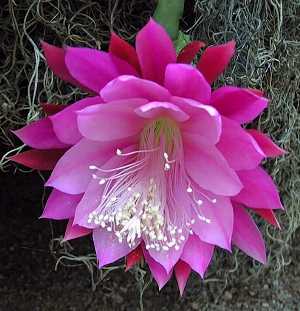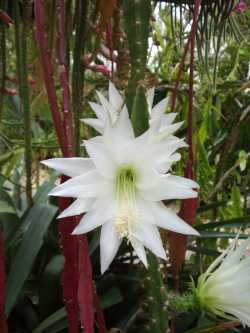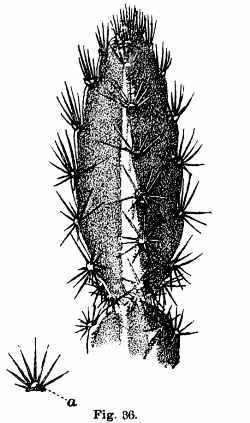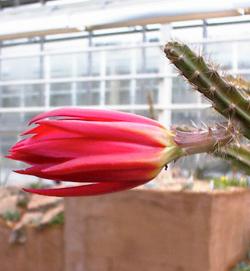Santa Marta, Pitaya de Cerro
Scientific Name: Disocactus speciosus (Cav.) Britton & Rose
Synonym: Cactus speciosissimus, Cactus speciosus, Cereus amecamensis, Cereus bifrons, Cereus serratus, Cereus speciosissimus, Cereus speciosus, Cereus speciosus var. amecamensis , Cereus superbus, Disocactus speciosus, Heliocereus amecamensis, Heliocereus serratus, Heliocereus speciosissimus, Heliocereus speciosus var. superbus , Heliocereus speciosus var. amecamensis , Heliocereus speciosus, Heliocereus speciosus var. serratus , Heliocereus superbus
Family: Cactaceae
AHS: 4
USDA: 10b-12
Frost Tolerance: Keep above 50°F (10°C)
Origin: Central Mexico
Growth Habits: Occasionally epiphytic, much branched, erect at first, stems reddish at first and then dark red, 3 to 5 sharp wavy ribs, 0.4 inch high; areoles 1.2 in. apart (3 cm), with whitish felt; 5 to 8 spines at first, 0.4 to 0.6 in. long (1-1.5 cm), yellowish.
Watering Needs: Regular water
Propagation: Cuttings

Epiphyllum hybrid with probably D. speciosus as an ancestor
A variety of D. speciosus with thicker 7-angled stems, reddish growing tops and glossy cinnabar red flowers was described as Heliocereus superbus. Heliocereus serratus, here also included in D. speciosus, has 4-angled (occasionally 3-angled) shorter stems, with serrated angles and stiff brownish spines.

Disocactus amecamensis at Holly Gate Nursery, photo Terry Hewitt.

Stem (as Cereus speciosus), picture from K. Schumann "Gesamtbeschreibung der Kakteen"
Blooming Habits:
Large pink to purplish-red flowers, up to 6 inches long (15 cm) with tuberculate ovary, green tube with reddish scales and white hairs. Edible red ovoid fruit, 1.2 to 2 inches long (3-5 cm).
A white flowered form of this species from Amecameca (Mexico State) was described as Heliocereus amecamensis.
Desert-Tropicals is dedicated to provide gardening advice, gardening ideas, and information about flower of all kind for landscape and collections.We try to check carefully the identification of the plants on the illustrations as well as the other information from the page, but occasionally errors do occur. if you notice anything that needs to be changed please contact us.Thanks.
© 1998-2020 Philippe Faucon, All Rights Reserved.
